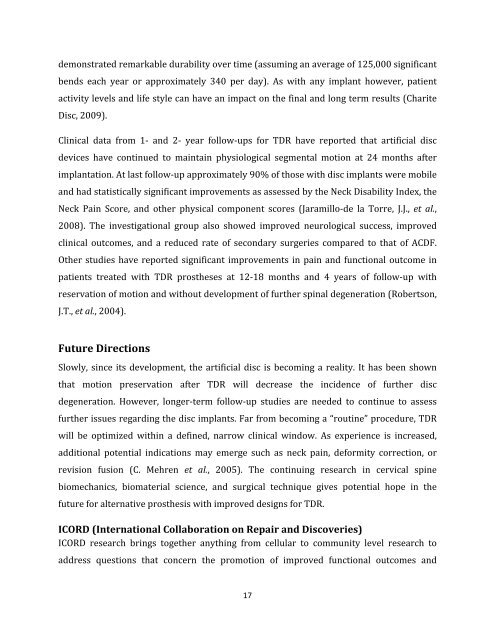Intervertebral Disk Replacement - Keivan Anbarani's Electronic ...
Intervertebral Disk Replacement - Keivan Anbarani's Electronic ...
Intervertebral Disk Replacement - Keivan Anbarani's Electronic ...
You also want an ePaper? Increase the reach of your titles
YUMPU automatically turns print PDFs into web optimized ePapers that Google loves.
demonstrated remarkable durability over time (assuming an average of 125,000 significant<br />
bends each year or approximately 340 per day). As with any implant however, patient<br />
activity levels and life style can have an impact on the final and long term results (Charite<br />
Disc, 2009).<br />
Clinical data from 1-‐ and 2-‐ year follow-‐ups for TDR have reported that artificial disc<br />
devices have continued to maintain physiological segmental motion at 24 months after<br />
implantation. At last follow-‐up approximately 90% of those with disc implants were mobile<br />
and had statistically significant improvements as assessed by the Neck Disability Index, the<br />
Neck Pain Score, and other physical component scores (Jaramillo-‐de la Torre, J.J., et al.,<br />
2008). The investigational group also showed improved neurological success, improved<br />
clinical outcomes, and a reduced rate of secondary surgeries compared to that of ACDF.<br />
Other studies have reported significant improvements in pain and functional outcome in<br />
patients treated with TDR prostheses at 12-‐18 months and 4 years of follow-‐up with<br />
reservation of motion and without development of further spinal degeneration (Robertson,<br />
J.T., et al., 2004).<br />
Future Directions<br />
Slowly, since its development, the artificial disc is becoming a reality. It has been shown<br />
that motion preservation after TDR will decrease the incidence of further disc<br />
degeneration. However, longer-‐term follow-‐up studies are needed to continue to assess<br />
further issues regarding the disc implants. Far from becoming a “routine” procedure, TDR<br />
will be optimized within a defined, narrow clinical window. As experience is increased,<br />
additional potential indications may emerge such as neck pain, deformity correction, or<br />
revision fusion (C. Mehren et al., 2005). The continuing research in cervical spine<br />
biomechanics, biomaterial science, and surgical technique gives potential hope in the<br />
future for alternative prosthesis with improved designs for TDR.<br />
ICORD (International Collaboration on Repair and Discoveries)<br />
ICORD research brings together anything from cellular to community level research to<br />
address questions that concern the promotion of improved functional outcomes and<br />
17


